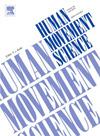Dual-task interference of reactive stepping kinematics for balance recovery strategies in older adults
IF 1.9
3区 心理学
Q4 NEUROSCIENCES
引用次数: 0
Abstract
Objective
To characterize the interference of reactive stepping kinematics related to the increase or maintenance of the number of steps in response to a large perturbation during dual tasks among older adults.
Methods
This was a cross-sectional study that included 52 community-dwelling healthy older adults. Reactive stepping performance was analyzed after forward balance loss during a single task and a second cognitive task. The number of steps taken to recover balance and dual-task interference (DTI) for muscular onset latency, anteroposterior (AP) center of pressure (COP) displacement and velocity before step initiation, and step temporal and spatial variables were measured. The DTI of the variables was compared between the participants who increased versus those who maintained the number of steps taken during the dual task relative to the single task.
Results
Twenty-eight (53.8 %) participants increased their steps during dual tasks relative to a single task. In older adults, the AP COP peak velocity (P < 0.001) and step length (P < 0.001) were significantly worse during dual tasks than during a single task. However, this was not observed for older adults who did not increase their steps. The DTI for the AP COP peak velocity and step length were significantly larger for the older adults who increased their steps than those who did not (AP COP peak velocity; P = 0.044, step length; P = 0.003). Both groups showed a significant muscular onset delay during dual tasks than during a single task (P < 0.001), and no significant differences were found between the groups.
Conclusions
Our findings suggest that reactive stepping strategies in older adults after a large external perturbation during secondary cognitive tasks can be attributed to interference with COP control before step initiation and step length.
双任务干扰老年人平衡恢复策略的反应步法运动学
目的:描述老年人在完成双重任务时,反应性步法运动学对增加或保持步数的干扰,以应对较大的扰动。
本文章由计算机程序翻译,如有差异,请以英文原文为准。
求助全文
约1分钟内获得全文
求助全文
来源期刊

Human Movement Science
医学-神经科学
CiteScore
3.80
自引率
4.80%
发文量
89
审稿时长
42 days
期刊介绍:
Human Movement Science provides a medium for publishing disciplinary and multidisciplinary studies on human movement. It brings together psychological, biomechanical and neurophysiological research on the control, organization and learning of human movement, including the perceptual support of movement. The overarching goal of the journal is to publish articles that help advance theoretical understanding of the control and organization of human movement, as well as changes therein as a function of development, learning and rehabilitation. The nature of the research reported may vary from fundamental theoretical or empirical studies to more applied studies in the fields of, for example, sport, dance and rehabilitation with the proviso that all studies have a distinct theoretical bearing. Also, reviews and meta-studies advancing the understanding of human movement are welcome.
These aims and scope imply that purely descriptive studies are not acceptable, while methodological articles are only acceptable if the methodology in question opens up new vistas in understanding the control and organization of human movement. The same holds for articles on exercise physiology, which in general are not supported, unless they speak to the control and organization of human movement. In general, it is required that the theoretical message of articles published in Human Movement Science is, to a certain extent, innovative and not dismissible as just "more of the same."
 求助内容:
求助内容: 应助结果提醒方式:
应助结果提醒方式:


